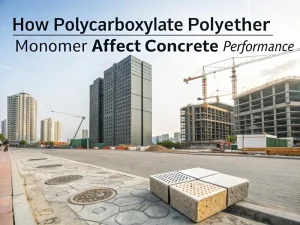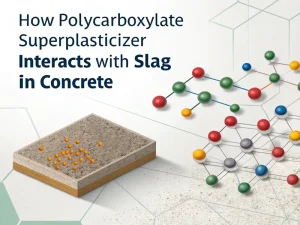Blog
In the fast-paced world of architecture, every decision from material selection to schedule management affects project efficiency, cost, and quality. Sometimes, choosing on-site mixing and ready-mixed concrete (RMC) can also affect project progress.
Although on-site mixing concrete may seem like a cost-effective option for small projects, pre-mixed concrete has become the preferred choice for commercial buildings, infrastructure, residential areas, and even medium-sized renovations.
If you are still hesitating whether to use ready-mixed concrete in your next project, this article will reveal why you should choose ready-mixed concrete.
In short, ready-mixed concrete is concrete produced in a specialized factory called a “mixing plant” using computer-controlled, automated equipment according to precise formulas. Then, it is loaded into a specially designed mixer truck and transported directly to your construction site while maintaining its operational status.
The performance of concrete—strength, durability, and workability—depends entirely on the precision of its mixing: the ratio of cement, aggregates (such as sand and gravel), water, and additives. On-site mixing relies on manual measurement (usually done by workers with different skill levels), resulting in inconsistency, excessive water weakens the concrete, while uneven distribution of aggregates can lead to cracks or voids.
This is the core reason for choosing ready-mixed concrete:
Accurate proportioning: At the mixing plant, all raw materials (cement, aggregates, water, additives) are accurately measured by the computer with minimal error. This ensures that each batch of concrete has exactly the same performance and strength, eliminating quality fluctuations caused by human estimation during on-site mixing.
Professional quality control: A professional mixing plant has a complete laboratory and quality control system. From raw material storage to concrete delivery, every step is rigorously tested to ensure compliance with national standards and design requirements (such as C30 and C40 strength grades).
Time is money, especially in the construction industry.
On-site mixing is a slow and labor-intensive process: workers must unload raw materials, set up mixers, measure ingredients, and clean equipment—all of which must be completed before pouring concrete.
Pre-mixed concrete shortens t
se time-consuming steps and achieves faster project turnover:
No on-site preparation required: You don’t need to store piles of cement, sand, and stones on the construction site, nor do you need to install and maintain the mixer. This creates valuable construction site space.
Ready to use: After the concrete mixer truck arrives, the concrete can be poured immediately through a chute or a pump truck. A skilled team can complete a large amount of pouring work in a few hours, which is completely incomparable to on-site mixing. Faster pouring means shorter construction period and earlier project delivery.
On-site concrete mixing requires a large and skilled labor team, where workers handle raw materials, operate mixers, measure additives, and perform cleanup tasks. In today’s construction industry, labor shortages and wage increases have become a significant financial burden.
Reduce labor costs: You no longer need to hire specialized workers for mixing and handling raw materials.
Zero material waste: Order on demand, accurately calculate usage. On-site mixing often results in some cement becoming damp and hardened, or leaving piles of sand and gravel that cannot be utilized, whereas ready-mixed concrete is almost never wasted.
No equipment cost: No need to purchase, lease, or maintain a concrete mixer.
The construction industry is one of the most resource-intensive industries, and on-site concrete mixing generates a large amount of waste:
Excessive mixing: Workers often mix excess concrete to avoid wasting it, resulting in the remaining materials being discarded into landfills.
Deterioration: On-site concrete solidifies quickly (especially in hot weather), so any unused mixture will harden and become unusable.
Raw material waste: Spilled cement, unused aggregates, and damaged bags can cause unnecessary waste.
Ready-mixed concrete is a more sustainable option that can reduce waste:
Accurate ordering: You only order the required quantity of concrete (with a small buffer zone). If more (or less) concrete is needed, the RMC factory can adjust the delivery quantity during the project to minimize over-ordering.
No deterioration: Mix RMC to control the “solidification time” (usually 90-120 minutes) and keep it fresh in a rotating truck. Unused concrete can be returned to the factory or used for smaller tasks such as curbstones and footings.
The performance of concrete is highly sensitive to weather: high temperatures can cause rapid solidification, while cold weather can slow down hydration (strength development). On-site mixing is difficult to adapt to these conditions – workers may add too much water at high temperatures (weakening the concrete), or not use accelerators at low temperatures (delaying solidification).
Ready-mixed concrete can be customized according to any condition or project:
Professional formula: RMC can be designed according to specific needs, such as high-strength concrete (used for bridges or high-rise buildings), self-compacting concrete (used for complex formwork), or lightweight concrete (used for precast slabs). On-site mixing rarely achieves these special properties consistently.
Consistent performance under all conditions: RMC’s controlled mixing environment ensures that the mixture remains stable during transportation, even in extreme weather conditions. On-site mixed concrete usually deteriorates (e.g., dries in the wind) or becomes excessively fluid (in the rain) before being poured.
On-site concrete mixing can bring several safety hazards:
Heavy lifting operations: Workers must move cement bags and aggregates, which increases the risk of back injuries.
Dust exposure: Inhalation of cement dust is toxic and can lead to respiratory problems, including silicosis. On-site mixing will generate a large amount of uncontrollable dust.
Mixer accidents: Improper operation of concrete mixers can result in crushing injuries or entanglement.
Pre-mixed concrete reduces these risks and creates a safer working environment:
The site is cleaner: piles of raw materials and mixing areas have been eliminated, making the entire construction site more organized and convenient for cross-operation of other trades.
Reduce air and noise pollution: On-site mixing generates a large amount of cement dust and continuous machine noise. The use of pre-mixed concrete can significantly improve the construction environment and be more friendly to workers and surrounding communities.
As a project manager, your focus should be on core management rather than trivial matters related to materials.
One-stop solution: You only need one phone call to explain to the supplier the concrete grade, quantity, and pouring time you need. From production to delivery, all the tedious intermediate steps are handled by the supplier on your behalf. This greatly simplifies procurement and supply chain management
In summary, choosing pre-mixed concrete is no longer an option, but an inevitable trend in modern construction engineering. It takes your project to a new professional level by providing reliable quality, unparalleled efficiency, and better overall cost.
Whether you are building high-rise buildings, roads, or backyard terraces, ready-mixed concrete can provide unparalleled value for on-site mixing. For contractors, developers, and homeowners seeking to avoid delays, minimize costs, and ensure long-term effectiveness, ready-mixed concrete is a clear choice.

How Polycarboxylate Polyether Monomer Affect Concrete Performance
Blog How Polycarboxylate

How Polycarboxylate Superplasticizer Interacts With Slag In Concrete
Blog How Polycarboxylate